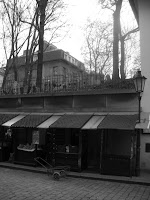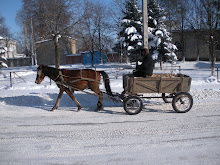 Grad school? Not so sure… I am almost certain I actually aspire to be a bike messenger in the city of Prague. I would willingly spend my days peddling the intricate streets, taking in the individual stories of each architectural masterpiece, and noticing new characteristics in the statues every single day. There are, in fact, more statues in this city than any other in Europe. Before literacy (and the need to tax residences), the city actually used these statues in place of naming and numbering streets. This would be the life.
Grad school? Not so sure… I am almost certain I actually aspire to be a bike messenger in the city of Prague. I would willingly spend my days peddling the intricate streets, taking in the individual stories of each architectural masterpiece, and noticing new characteristics in the statues every single day. There are, in fact, more statues in this city than any other in Europe. Before literacy (and the need to tax residences), the city actually used these statues in place of naming and numbering streets. This would be the life.
I can’t even begin to discern which of the 200 photographs I took of the Golden City are my favorites, so you can click below to view the full album. Also the little comment box turns on the captions. None of them do the city justice. GO TO PRAGUE!
My experience of Prague was most certainly influenced by my current mailing address. Moldovans and Czechs were both subjects of the Soviet regime, but their experiences and opinions of that era are not exact replicas. Add to this the Czech suppression by Hitler’s thumb, and the half dozen or so other parties over the last several centuries, and you can quickly appreciate the Republic’s current independence. Literally, only in the last three decades has this country been able to [finally] breath!
But the western world, by which I refer to the authors of my high school and college history books, barely even notice the events that took place in Bohemia. For example, only in my preparation for this trip did I learn that Martin Luther was not exactly an original thinker. Jan Hus, a Czech priest began preaching in the Czech language (not Latin) against the Catholic Church a full 100 years before Martin Luther made his stand. He was burned at the stake in Prague’s Old Town Square for his actions. His followers (known as the “Hussites,” and later “Bohemian Estates”) actually started the Thirty Year’s War by throwing two men out a window in Prague Castle in protest against the Catholic regime’s failure to deliver on promises of religious tolerances (both men survived thanks to a rather amenable pile manure).
 Now, I realize that may not fascinate all of you, so here is a short list of other things you might appreciate that started in the Czech Republic: the sugar cube, contact lenses, the bullets currently being used in Iraq, Pilsner Urquell (very impressive!), and one of Mozart’s most famous operas (apparently it didn’t impress me too much since I can’t remember which one!). In fact, the building (left) where Mozart debut his opera is actually the only place left in the world where the famous musician played before a public audience.
Now, I realize that may not fascinate all of you, so here is a short list of other things you might appreciate that started in the Czech Republic: the sugar cube, contact lenses, the bullets currently being used in Iraq, Pilsner Urquell (very impressive!), and one of Mozart’s most famous operas (apparently it didn’t impress me too much since I can’t remember which one!). In fact, the building (left) where Mozart debut his opera is actually the only place left in the world where the famous musician played before a public audience.  One of the oldest neighborhoods in the city is the Jewish Quarter. At one time, the city’s entire Jewish population was literally walled into this small area, which is why the old cemetery is so famous. Overcrowding soon took over and only one square block could be dedicated to the dead. So the bodies were literally buried in rows until the wall came down. The stories say they cemetery is as deep as ten graves in some places.
One of the oldest neighborhoods in the city is the Jewish Quarter. At one time, the city’s entire Jewish population was literally walled into this small area, which is why the old cemetery is so famous. Overcrowding soon took over and only one square block could be dedicated to the dead. So the bodies were literally buried in rows until the wall came down. The stories say they cemetery is as deep as ten graves in some places.There are many other stories for this area of Prague. Almost every synagogue has a story behind its existence, the stories of Jewish children are displayed in a small museum near the cemetery (remnants of artwork a teacher managed to salvage after the children were taken away), and a statue of Franz Kafka literally guards the main entrance to the neighborhood. But the one story I would like to research more is the role of the Jewish Quarter in Hitler’s master plan. Hitler, according to our tour guide, actually planned to use the neighborhood as a museum to a dead race after his extermination campaign was complete. I want to find out why he would go through the effort to do that, and if anyone knows of some literature on this story, please forward it to me. But, at least we can saw this: He did not succeed.
Irony can add some sweet to the “bitter-sweet” story of Hitler’s presence in Prague. The man really did like Prague, and its classical music. Our tour guide told us the story of the day he ordered his men to remove a statue, of a Jewish composer, from the concert hall roof. These guys had no idea which of the four was the intended victim and decided to guess based on the size of one particular sculpture’s nose structure. The true victim was a Czech composer, Hitler’s all time favorite.
Night life in Prague lives up to its fame, and is popular with ex-pats. For example, chatted with a guy of FILIPINO descent who was born in the UNITED STATES to DUTCH parents and studied at university in LONDON. Though, he lived a good portion of his life in SWITZERLAND, where his kid sister was born. [Mom and Shirley: Doesn’t this remind you of Nadya? The waitress in Brussels with the Italian/Sicilian/Greek/French story!] Or how about the ENGLISH bar tender serving up Jen’s IRISH cider in a MEXICAN restaurant, in the CZECH REPUBLIC. That was actually our best meal of the whole trip… We also met lots of other Americans while we were out; students, soldiers, and tourists alike.
 While it was great to catch up with some fellow yanks, I do wish we had a bit more interaction with Czechs while we were there. We simply were just too confined to the English Speaking Tourist Zone [with the exception of the post office, and let’s face it, that’s not all that much of a conversation starter]. In fact, despite that Jen and I learned how to say “thank you” in Czech within our first hour in the city, we probably thanked people in Romanian by accident more often that we attempted to use the Czech. English speakers have it so easy.
While it was great to catch up with some fellow yanks, I do wish we had a bit more interaction with Czechs while we were there. We simply were just too confined to the English Speaking Tourist Zone [with the exception of the post office, and let’s face it, that’s not all that much of a conversation starter]. In fact, despite that Jen and I learned how to say “thank you” in Czech within our first hour in the city, we probably thanked people in Romanian by accident more often that we attempted to use the Czech. English speakers have it so easy. This was my first trip with a traveling companion in quite some time and I am grateful that Jen was along. It went something like this: I took control of the map, and Jen kept the key to the hostel. We managed to deck out our passports throughout the bus ride to and from the Golden City: Moldova, Romania, Hungary, Slovakia, Czech Republic, Poland, and Ukraine. And…I think that’s a wrap!




























Thanks to your pics I'm sold on a trip to the Czech Republic. Looks like y'all enjoyed yourselves.
ReplyDeleteThis snow came from nowhere, right?
Actually, the further east we came, the harder it snowed...was slow going all the way through Poland and Ukraine. Definately go, it's a beautiful country. I think I have to spend my vacation time going to other former Soviet states. Every side of the story is related, but very different.
ReplyDeleteDrum bun!